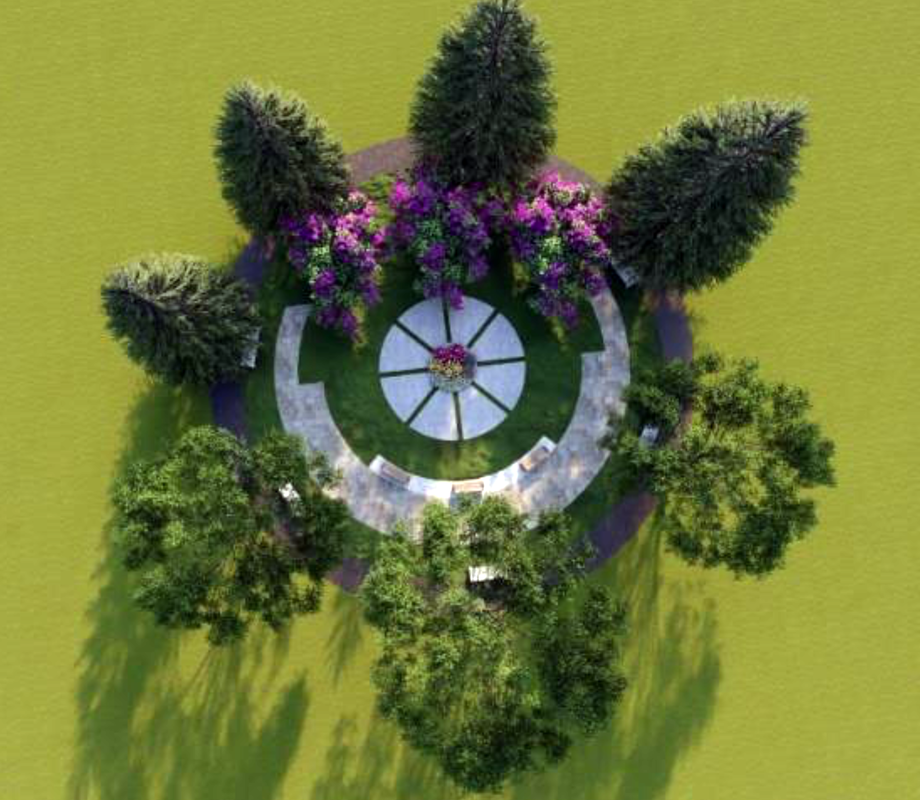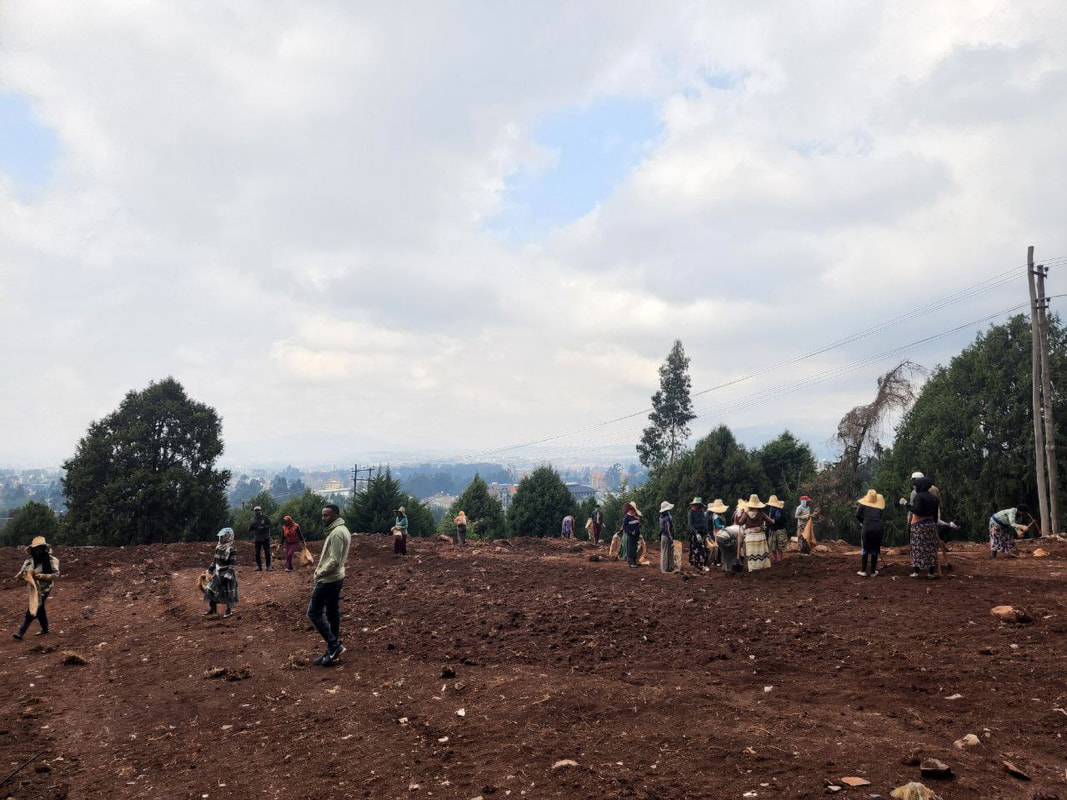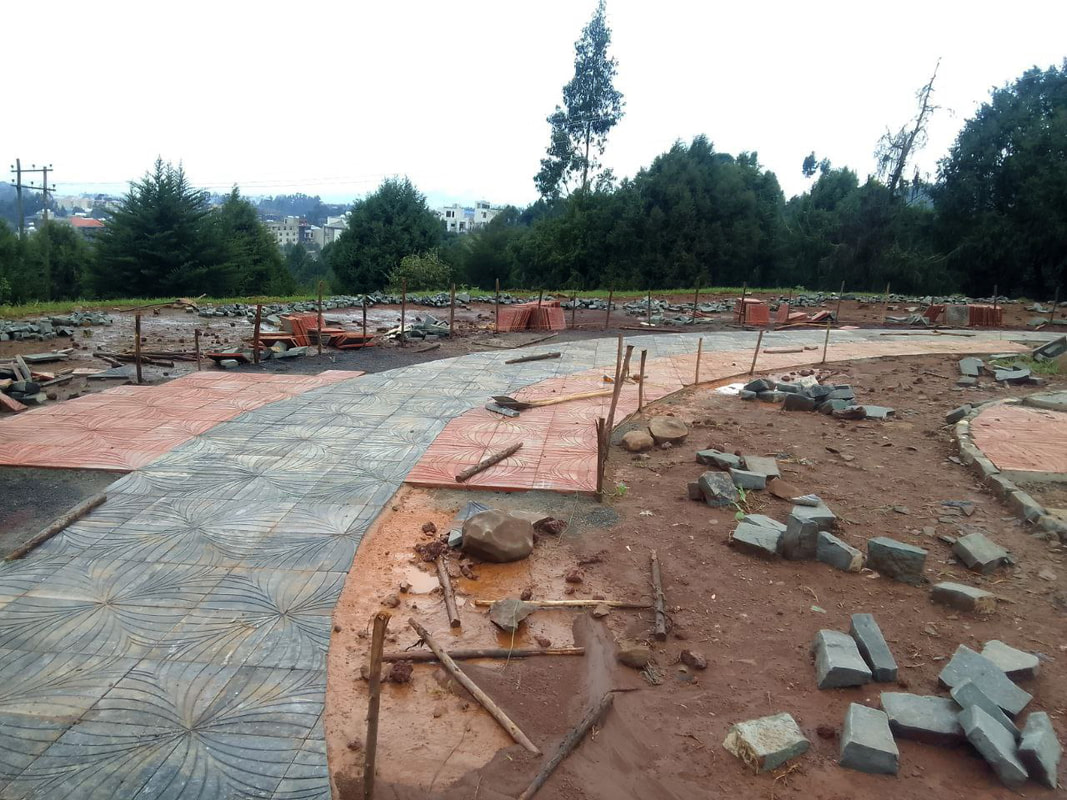INDIGENOUS PLANTED TREE CIRCLE at
GULLELE NATIONAL BOTANIC GARDEN, ADDIS, ETHIOPIA
GULLELE NATIONAL BOTANIC GARDEN, ADDIS, ETHIOPIA
Celebrating a tree planting success and climate art at Ethiopia's National Botanic Park system
Nura Beshir
Nura Beshir
Laying out the Gullele Tree Circle at the National Botanic Garden, Autumn 2022
PLANTING THE GULLELE EARTH OBSERVATION TREE CIRCLE
Since botanic gardens are focused on the conservation, research and innovative ways to share learning about flora, Trees4Life project advisor, Nura Beshir, approached the National Gullele Botanic Garden director and staff about the potential planting of a Tree Circle on site. Of note ongoing tree planting programs to assist in climate mitigation have always been a part of Ethiopia's own efforts to combat greenhouse gases since the 1990s; however, the ability to portray Ethiopia's own tree planting achievements in an artistic form from an aerial perspective was a new concept and welcomed by Gullele Botanic Gardens. Aligning with the Guellele Botanical Garden's objectives of developing world class nature-based eco-friendly recreational facilities whilst offering environmental education for sustainability, the proposal was embraced as an opportunity for new levels of engagement at the local, regional and international arenas. In particular the Garden was pleased to support and showcase how local and self initiated community tree nurseries can be significant contributors to the country's reforestation and climate mitigation efforts. Many of the trees that form part of the Gullele National Botanic Tree Circle include saplings sourced from the Trees4Life community operated plant nursery in Kofele, West Arsi, Oromia, Ethiopia.
The concept of creating a set of 'living artworks' was further welcomed as a a visual platform from which to extend the national narrative about the need to undertake impactful climate measures through flora planting. Living artworks become visible as they grow revealing their canopies and mitigation benefits to the world as eco-art spaces captured by satellites and observed on the Google Earth web platform.
PLANTING THE GULLELE EARTH OBSERVATION TREE CIRCLE
Since botanic gardens are focused on the conservation, research and innovative ways to share learning about flora, Trees4Life project advisor, Nura Beshir, approached the National Gullele Botanic Garden director and staff about the potential planting of a Tree Circle on site. Of note ongoing tree planting programs to assist in climate mitigation have always been a part of Ethiopia's own efforts to combat greenhouse gases since the 1990s; however, the ability to portray Ethiopia's own tree planting achievements in an artistic form from an aerial perspective was a new concept and welcomed by Gullele Botanic Gardens. Aligning with the Guellele Botanical Garden's objectives of developing world class nature-based eco-friendly recreational facilities whilst offering environmental education for sustainability, the proposal was embraced as an opportunity for new levels of engagement at the local, regional and international arenas. In particular the Garden was pleased to support and showcase how local and self initiated community tree nurseries can be significant contributors to the country's reforestation and climate mitigation efforts. Many of the trees that form part of the Gullele National Botanic Tree Circle include saplings sourced from the Trees4Life community operated plant nursery in Kofele, West Arsi, Oromia, Ethiopia.
The concept of creating a set of 'living artworks' was further welcomed as a a visual platform from which to extend the national narrative about the need to undertake impactful climate measures through flora planting. Living artworks become visible as they grow revealing their canopies and mitigation benefits to the world as eco-art spaces captured by satellites and observed on the Google Earth web platform.
Above: Landscape concept designs (copyright Nura Beshir) depict the Gullele National Botanic Tree Circle as an area for refuge, contemplation, and learning. Indigenous trees, shrubs and medicinal plants were selected for this planting un order to reflect Ethiopia's diverse flora.
GULLELE NATIONAL BOTANIC TREE CIRCLE PROJECT AIMS and ACHIEVEMENTS
- Create a set of Tree Circles that provide a public space for recreation and reflection on the benefits of indigenous trees to Ethiopia
- Facilitate dialogue on the roles of people and communities in working together to address climate change at local and global levels through tree planting
- Deliver a unique living artwork to represent Ethiopia's ongoing greening and climate efforts that is also observable on Google Earth for a global audience

Gullele National Botanic staff selected several locations for the proposed Tree Circle; however, this site at 9.07245142993744, 38.72127330562939 was selected for its ability to be seen by satellite and it was adjacent to othe public amenities including schools.
The emergence of the concentric circle planting and paving can be already seen on this Google Earth image captured a couple months after the planting's completion. At present the terrazzo and cobblestone are the main features that can be seen by satellite. The trees will become much more dominant in the following months as they flourish and spread their canopies.
See the location on Google Earth https://earth.google.com/web/search/9.0785%c2%b0+N,+38.7209%c2%b0+E/@9.0725684,38.72126403,2653.93190032a,146.47746795d,35y,131.27474834h,0t,0r/data=CigiJgokCaDBKyo4lRxAEQlxNSnrVxxAGaqtdCNdZUNAIerP4NVIXkNA
How has the TREE CIRCLE project impacted local climate thinking
Planting trees and verges as a conservation tool is fundamental in order to enable natural processes and ecosystems to start. Projects such as a the planting of a Tree circle (2022) can be carried out by communities on brown field, agricultural, or environmentally degraded land sites. Cities are now increasingly declaring both a climate and ecological emergency and are needing to find creative ways to inspire and move residents towards giving nature a more central role in their environments.The planting of a tree circle while it may be defined as simple does offer a viable nature-based solutions that does ‘work with’ green infrastructure that can provide connectivity points required to give nature the freedom to drive environmental change and enable the re-establishment of even further natural and wilding processes.
SEVERAL KEY LESSONS LEARNED
Remember to think local
The reinstatement of natural processes into new and existing ecological spaces, such as the introduction of indigenous plants, assisting the water and river tables at a local level can all support there- emergence and function of sustainable, biodiverse and connected ecosystems now and into the future
Acknowledge past, present, and future landscapes as part of the design processes
The design restoration processes and/or creation of flora habitats needs to account and acknowledge a site's topography, peoples and natural histories of the land as well as the current and future implications of the climate on these locales. The completed Tree Circle was months behind schedule due to unexpected climate weather variations, flooding. These events aided in reconsidering the design and selecting even more robust trees for the final planting.
Recognise opportunities to support local well being and economies
Flora and nature based projects can provide socio-economic benefits and opportunities, such as increasing access to ecosystem services and green spaces as well as introducing new job and skill creations. A Tree circle project can be scaled and easily delivered by other communities for learning, climate and economic benefit.
Work at an appropriate scale
Project scale from site function and size will assist in determining what’s best. Think about the support and ongoing co-existence of nature and people needed to create robust systems and the overall eco-legacies. People and communities can be be drivers of change without even knowing it.
“Our world must not only become net zero, but also nature positive, for the benefit of both people and the planet, with a focus on promoting sustainable and inclusive development. Nature, and the biodiversity that underpins it, ultimately sustains our economies, livelihoods and well-being.” from G7- 2030 Nature Compact report (2021)
What's happening - next steps
The project in the next months will include monitoring and data collection to understand the changes in the landscape and the diversity of plant and animal species. It is expected that the area will experience increased pollinators such as butterflies and bees and other species such as bats. Additionally the garden's wider ethos of climate action and building stronger communities is already starting to take seed with local school groups starting to use the Tree circle for outdoor meetings, classes and related educational activities.
Building of the National Gullele Botanic Tree Circle: A Visual Guide
Planting trees and verges as a conservation tool is fundamental in order to enable natural processes and ecosystems to start. Projects such as a the planting of a Tree circle (2022) can be carried out by communities on brown field, agricultural, or environmentally degraded land sites. Cities are now increasingly declaring both a climate and ecological emergency and are needing to find creative ways to inspire and move residents towards giving nature a more central role in their environments.The planting of a tree circle while it may be defined as simple does offer a viable nature-based solutions that does ‘work with’ green infrastructure that can provide connectivity points required to give nature the freedom to drive environmental change and enable the re-establishment of even further natural and wilding processes.
SEVERAL KEY LESSONS LEARNED
Remember to think local
The reinstatement of natural processes into new and existing ecological spaces, such as the introduction of indigenous plants, assisting the water and river tables at a local level can all support there- emergence and function of sustainable, biodiverse and connected ecosystems now and into the future
Acknowledge past, present, and future landscapes as part of the design processes
The design restoration processes and/or creation of flora habitats needs to account and acknowledge a site's topography, peoples and natural histories of the land as well as the current and future implications of the climate on these locales. The completed Tree Circle was months behind schedule due to unexpected climate weather variations, flooding. These events aided in reconsidering the design and selecting even more robust trees for the final planting.
Recognise opportunities to support local well being and economies
Flora and nature based projects can provide socio-economic benefits and opportunities, such as increasing access to ecosystem services and green spaces as well as introducing new job and skill creations. A Tree circle project can be scaled and easily delivered by other communities for learning, climate and economic benefit.
Work at an appropriate scale
Project scale from site function and size will assist in determining what’s best. Think about the support and ongoing co-existence of nature and people needed to create robust systems and the overall eco-legacies. People and communities can be be drivers of change without even knowing it.
“Our world must not only become net zero, but also nature positive, for the benefit of both people and the planet, with a focus on promoting sustainable and inclusive development. Nature, and the biodiversity that underpins it, ultimately sustains our economies, livelihoods and well-being.” from G7- 2030 Nature Compact report (2021)
What's happening - next steps
The project in the next months will include monitoring and data collection to understand the changes in the landscape and the diversity of plant and animal species. It is expected that the area will experience increased pollinators such as butterflies and bees and other species such as bats. Additionally the garden's wider ethos of climate action and building stronger communities is already starting to take seed with local school groups starting to use the Tree circle for outdoor meetings, classes and related educational activities.
Building of the National Gullele Botanic Tree Circle: A Visual Guide
Local community members and botanic staff gardeners were engaged in clearing the land of large boulders (2022)
The concentric circles were achieved by using a central post as the pivot from which to 'draw' and stake the outer rings for both the plantings and pavement
Black and red terrazzo tiles were selected to create a welcoming space where people could easily gather and walk around the tree circle
Cobblestones were used to separate the two tree circles and to break the large centre space. Top soil was also placed on site to assist in the establishment of different grass covers.
Four set of benches were included to act like cardinal points on the second outer circular ring creating spaces for people to sit and enjoy nature in situ












